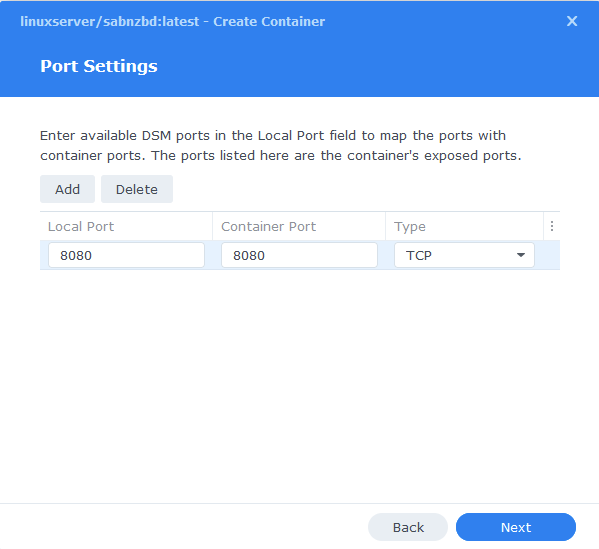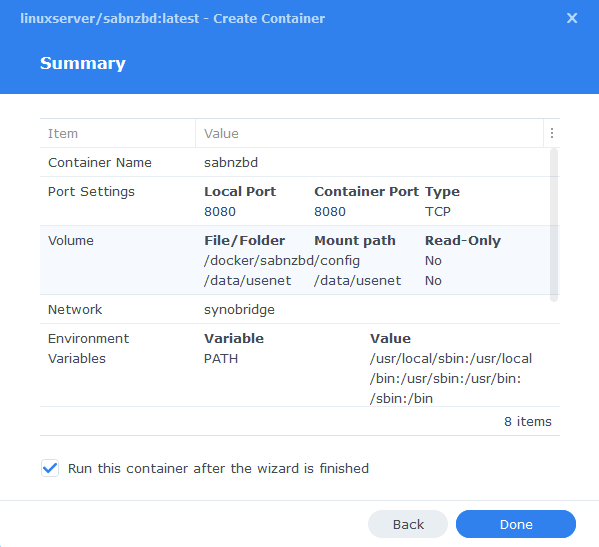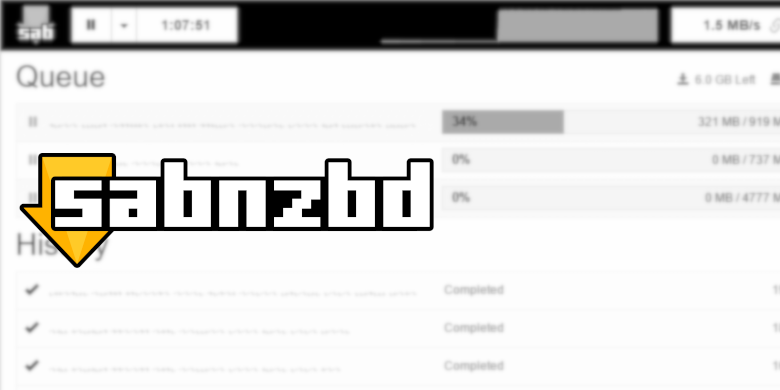Last updated on 6 April 2025
Please note if you are using DSM7.2 or higher you should use the Container Manager version of this guide from the menu.
This guide has reached the end of its updates as most people are now on the latest DSM update - This guide is correct as of 08/12/2023 however no further updates will be added.
| Update | Date |
|---|---|
| Amended the path to save the compose file – this is for security, so the container has no access to the file contents. | 14/04/2023 |
What is SABnzbd?
SABnzbd is a binary newsreader, it is used to download files from Usenet, and where required will also repair and extract releases. It works on its own or in conjunction with other tools such as Lidarr and Radarr.
Let’s Begin
In this guide I will take you through the steps to get SABnzbd up and running in Docker.
In order for you to successfully use this guide please complete the three preceding guides
- Step 1: Directory Setup Guide
- Step 2: Setting up a restricted Docker user
- Step 3: Setting up a Docker Bridge Network
Downloading the SABnzbd Image
Open up Docker within DSM and navigate to the ‘Registry’ tab and search for ‘SABnzbd’.
In the list of available containers select the one made by Linuxserver as shown below, right click on it and select ‘Download’ or click the button at the top of the window.

The pop-up box will ask which version you want to download, make sure you choose ‘Latest’ from the list of available versions.

You can check the status of the download over on the ‘Image’ tab.
Setting up the container
In Docker click on the ‘Image’ tab, in the list of your containers select the ‘Linuxserver SABnzbd’ image and click on ‘Launch’
You will be greeted with the Network screen, we will be using the ‘synobridge’ network we created earlier select it from the list and click Next.

General Settings
Next you will be greeted with the General Settings screen, this is where you can start specifying some of your preferences.
You can change the name of the container to anything you like, and you may want to enable Auto Restart as this will ensure SABnzbd starts automatically if you reboot your NAS.

Next up we are going to click on the ‘Advanced Settings’ button, this will take you to a new window with a number of tabs which we are going to work through.
Environment (PGID, PUID and Timezone)
Next we are going to set up a couple of environment variables that docker will use to allow the container access to our files and folders and also to tell it where we live in the world.
Click the Add button, and fill in the following details as per the table/screenshot, you will need to do one at a time.
| Variable | Value |
|---|---|
| PUID | The UID you obtained in the user setup guide |
| PGID | The GID you obtained in the user setup guide |
| TZ | Your timezone wikipedia.org/wiki/List_of_tz_database_time_zones |

Links/Execution Commands
You do not need to set up anything on these tabs.
Press ‘Save’ to go back to the initial setup screen, then press ‘Next’
Port Settings
We won’t be changing any of the ports the container uses. You can repeat the ones shown on the right side of the settings page ‘Container Port’ onto the left side ‘Local Port’ once you have done this press ‘Next’.

Volume Settings
We will now be specifying the directories where SABnzbd will store its configuration files and where download files.
Click on Add Folder, click on the docker share and create a new sub-folder called ‘sabnzbd’ select this folder and click ‘select’

You will now repeat this step but this time adding the /data/usenet folder and then add the Mount Paths as per the table / screenshot below.
| File/Folder | Mount path |
|---|---|
| docker/sabnzbd | /config |
| data/usenet | /data/usenet |

Click Next to move to the final screen.
Summary
You have now completed the setup of the container.
You will be shown an overall summary of the settings we have specified, this is a good time to double-check everything is correct. Finally, click on Done and the container should start to boot.

Some final steps
SABnzbd will now be running on port 8080 you can connect to it by going to the IP address of your NAS with that port
e.g. 192.168.0.40:8080
Once you have completed the setup wizard, go into the settings and amend your folders to the following
(Please note, if you have trouble accessing the setup wizard or get an error after the first step. Stop the Docker package in the Package Centre and restart it, or in some cases do a reboot)
After the initial set up you will need to ensure the ‘Folders’ settings are in line with the table/screenshot below.
| Setting | Path |
|---|---|
| Temporary Download Folder | /data/usenet/intermediate |
| Completed Download Folder | /data/usenet/completed |
| Watched Folder | /data/usenet/nzb |

| Historic Updates | Date |
|---|---|
| Added Docker Compose details Added new folder mappings to ensure atomic moves and Hard-linking | 03/05/2021 |
| Guide re-written and updated with DSM7 screenshots | 01/08/2021 |
| Added note about rebooting if you are unable to access the Setup Wizard | 14/01/2022 |
| Updated steps and screenshots for DSM7.1 | 02/07/2022 |
| Added new port settings and Docker Bridge Network | 24/07/2022 |
| Compose version number removed and small wording amendments | 08/04/2023 |
Looking for some help, join our Discord community
If you are struggling with any steps in the guides or looking to branch out into other containers join our Discord community!
Buy me a beverage!
If you have found my site useful please consider pinging me a tip as it helps cover the cost of running things or just lets me stay hydrated. Plus 10% goes to the devs of the apps I do guides for every year.




How do we have to configure SABnzbd so that we can securely connect with https://192.168.0.40:8081 or https://NASname:8081 to the GUI in a browser?
That is a question and a half lol.
Number 1 is built in – You would go into the SAB settings > General and enable HTTPS and specify the additional port of 8081, You would then need to add this port to the containers port mappings so 8081 maps to 8081 on the container. You will then have https using a self-signed cert, this means your browser will give warning about the certificate not being valid however the communications will be encrypted on that port.
The latter there are a ton of approaches some more difficult than others depending on whether you want to expose the apps to the internet (short TLDRs below!)
A) Using the Synology Reverse Proxy and SSL certificates (see my Overseerr/Jellyseerr guides for the steps) and expose port 443 to the internet and making sure you turn on all login options for the apps!
B) Using your own domain name and then setting up an independent proxy like Nginx Proxy Manager. Then by using DNS Challenges you can have SSL inside your LAN without touching the internet (Some of us just did this on Discord) it was an adventure!!
C) Lots of other methods using Tailscale for Certs etc..
I’ve fixed it, the user details were missing from the environment variables, luckily as I’d backed up I could go into the JSON file and find them in there, Added the environment variables back in and now it appears to be working.
Found that because I went through your guide again to make sure I’d not missed anything, so thanks again for taking the time to write such detailed guides, they’ve helped me on numerous occasions!
Now I’ve just got to figure out why sab is limiting my download speed to 6.5MB/s…..
Glad you sorted it! Speed wise check that you are not over doing the amount of connections, your provider will give you 30 but you may only need 15 to saturate things
I’ve had the same issue as above, updated from Sab version 2. something to the latest version, initially it wouldn’t load so I deleted the image (backed it up first) and reloaded, now it loads fine. All the config looks correct, but the user permissions have been nuked. So I just keep getting the error below
Failed making (/Downloads/Incomplete)
Traceback (most recent call last):
File “/app/sabnzbd/sabnzbd/filesystem.py”, line 727, in create_all_dirs
os.mkdir(path_part_combined)
PermissionError: [Errno 13] Permission denied: ‘/Downloads/Incomplete’
I think this is because there is no system user for sc-sabnzbd, it appears I can’t create a system user, and now I’ve no idea how I’m supposed to fix this. Any ideas?